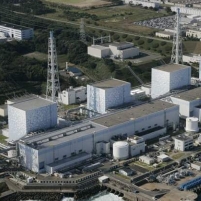Meltdown at Japanese Nuclear Power Plant…A Disaster Waiting to Happen
Sunday, March 13, 2011
 Fukushima reactor No. 1 before the explosion (photo: Kyodo News via AP)
Fukushima reactor No. 1 before the explosion (photo: Kyodo News via AP)
To hear some Japanese officials talk, you might think that the crisis at the Fukushima Daiichi Nuclear Power Plant was unavoidable. In fact, the plant has a long and disturbing history of trouble that includes damage by previous earthquakes, rigged inspection results and multiple lawsuits brought against it by local residents who may suffer from this current disaster.
The first reactor at Fukushima, supplied by General Electric, began commercial operation in March 1971. Several more reactors would go online over the next ten years.
Problems appeared early on, as corrosion cracks showed up several times between 1975 and 1977.
In 1975, 401 nearby residents filed a lawsuit asking for cancellation of the government’s license to continue building reactors at the site. Their case was finally rejected by a Japanese court nine and a half years later.
On the night of January 1, 1989, a recirculation pump in the No.3 reactor at the No. 2 Fukushima Power Plant began experiencing “abnormal vibrations.” However, the Tokyo Electric Power Company (TEPCO), which operated the plant, did not immediately report the problem to the government and did not shut down the plant until six days later. Japan’s Nuclear Safety Commission would later criticize the energy utility for its “sloppy” handling of the incident. It was discovered that more than twenty metal fragments from the pump had made their way into the reactor’s core. The reactor did not reopen until 21 months later.
This incident led to public skepticism about the nation’s reliance on nuclear power. Not to worry, though. A 1990 government white paper assured Japanese citizens that Japan’s nuclear reactors were much safer those in the United States and that the likelihood of a grave accident at any given facility was one in 100,000 years.
Despite this optimism, just two months later a leak of 55 tons of radioactive water at a different plant led to Japan’s first emergency core cooling system activation. The national anti-nuclear movement grew, and another lawsuit was filed on behalf of residents living near the Fukushima plant, demanding that it be shut down and calling for the power company to release documents relating to the 1989 accident.
On February 22, 1993, a high pressure steam accident at Fukushima killed one worker and injured two others. A leak of radioactive water occurred in June 1997, and in October 1999, radioactive waste from Fukushima leaked from two barrels at a disposal center in the far north of Japan’s main island of Honshu. The Fukushima plant also experienced trouble when the Y2K computer bug disrupted positioning of control rods at the No. 2 reactor.
The plant was hit by a 6.1 magnitude earthquake in July 2000 and was forced to shut down because of a leak of radioactive water. A 5.5 quake rattled the area in February 2002.
In 2001, local authorities clashed with the federal government over the safety of the Fukushima plant, in particular the decision to introduce plutonium-uranium mixed oxide (MOX) fuel, which was first delivered by a British ship in 1999. In March 2001 a district court dismissed a lawsuit by 864 local residents asking that MOX fuel not be used at Fukushima. Currently only Fukushima’s reactor No. 3 uses MOX, while the others use only uranium, which is less dangerous.
The big scandal relating to the Fukushima plant broke in 2002 when Japan’s Nuclear and Industrial Safety Agency revealed that it had found 29 alleged cases of the Tokyo Electric Power Company falsifying safety reports about cracks detected at its various plants, most of them at Fukushima. The false reports had been outsourced and conducted by…General Electric. In one case, GE recommended using a repair method used in the United States, but not approved for use in Japan. TEPCO went ahead and used the method anyway. The uproar that followed the revelation of TEPCO’s misdeeds caused a suspension of operations until safety checks could be performed at all its reactors, but TEPCO was again accused of violating its own safety measures during an inspection in February 2003.
The No. 1 reactor, shut down for almost three years, was finally restarted on July 13, 2005. However, it was shut down again less than a month later when a radioactive leak containing levels of tritium 8,000 times more than normal was discovered. Days later, a 6.8 magnitude earthquake caused injuries in nearby Sendai.
Further emergency shutdowns took place in October 2005 and February 2006. Then, on June 14, 2008, a 7.2 magnitude earthquake, which killed three people and knocked down a bridge, caused five gallons of radioactive water to spill out of a pool that stored spent fuel.
Following the massive earthquake on March 11, an explosion occurred at Fukushima Daiichi’s reactor No. 1. The reactor’s 40-year license was due to expire on March 26, however there was no indication that the Japanese government planned to actually close the reactor. On Sunday, cooling failed at a second Fukushima reactor, No. 3, and it is presumed that both reactors are experiencing meltdowns. Meltdown can release deadly radiation. As a precaution, Japanese authorities are evacuating hundreds of thousands of people who live near the nuclear power plant.
-David Wallechinsky
- Top Stories
- Unusual News
- Where is the Money Going?
- Controversies
- U.S. and the World
- Appointments and Resignations
- Latest News
- Trump Changes Name of Republican Party
- The 2024 Election By the Numbers
- Bashar al-Assad—The Fall of a Rabid AntiSemite
- Trump Announces He Will Switch Support from Russia to Ukraine
- Americans are Unhappy with the Direction of the Country…What’s New?






Comments